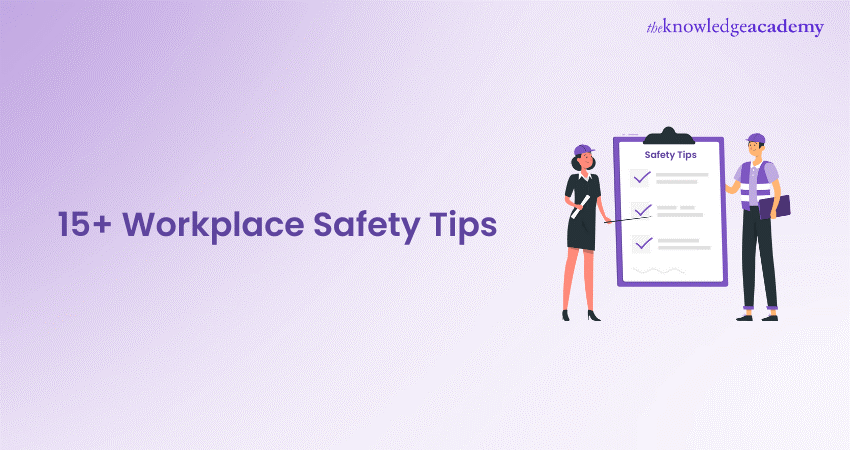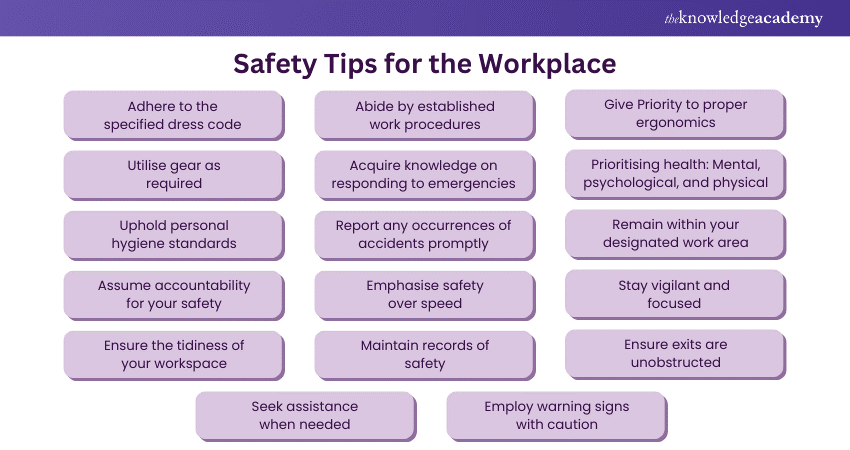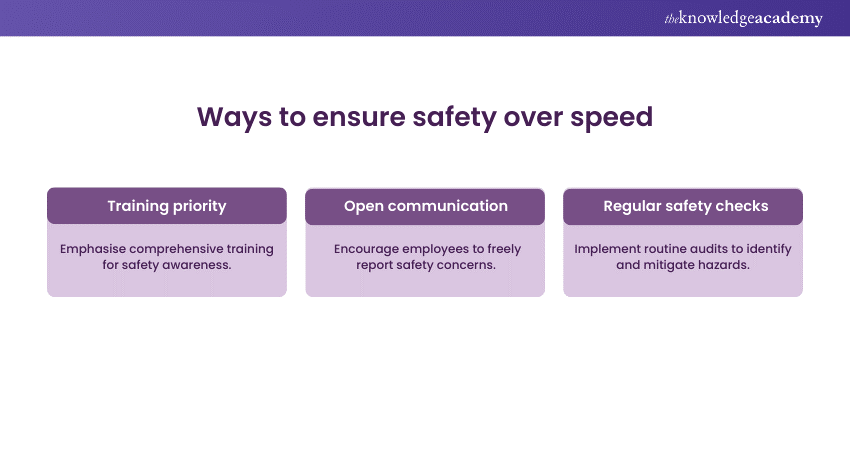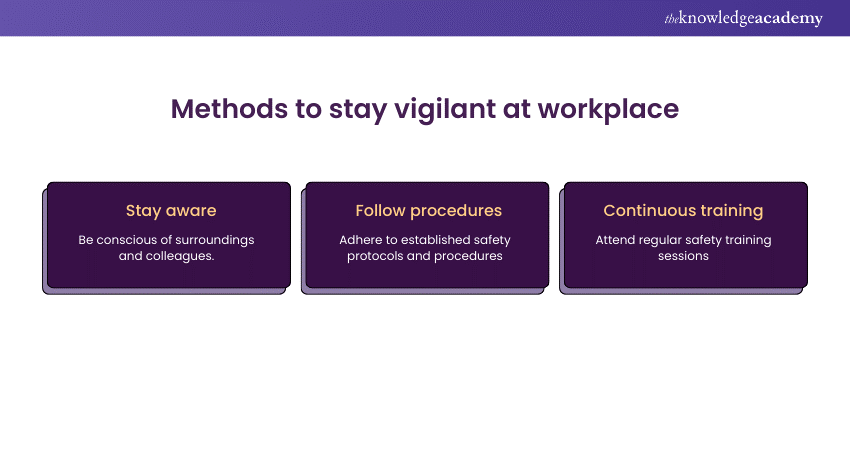We may not have the course you’re looking for. If you enquire or give us a call on +352 8002-6867 and speak to our training experts, we may still be able to help with your training requirements.
We ensure quality, budget-alignment, and timely delivery by our expert instructors.

Workplace Safety is the condition of being protected from harm or injury at work. It is essential for both employers and employees, as it can boost their well-being, performance, and reputation. However, Workplace Safety is not a one-time or one-person task and requires continuous effort. Understanding the Workplace Safety Tips can help you raise awareness and apply the best practices and standards for Workplace Safety.
To help you achieve Workplace Safety, we have compiled a list of 15+ Workplace Safety Tips to guide you and your coworkers on preventing and reducing the risks of accidents, injuries, or illnesses at work. These tips are also easy to follow and implement, as they do not require any special equipment or training. However, they can make a big difference in your safety and health and your coworkers' and visitors' safety and health.
Table of Contents
1) 15+ Essential Safety Tips for the Workplace
a) Adhere to the specified dress code
b) Utilise gear as required
c) Uphold personal hygiene standards
d) Assume accountability for your safety
e) Ensure the tidiness of your workspace
f) Abide by established work procedures
g) Acquire knowledge on responding to emergencies
h) Report any occurrences of accidents promptly
i) Emphasise safety over speed
j) Maintain records of safety
2) Conclusion
15+ Essential Safety Tips for the Workplace

Here are some highly effective tips to help you improve Safety in your Workplace:
1) Adhere to the specified dress code
The dress code protects you from hazards and risks at work, such as heat, cold, dust, chemicals, or electricity. It also prevents injuries or accidents from wearing inappropriate or loose clothing. Therefore, wear the appropriate clothing and footwear for your job, and avoid any jewellery, accessories, or items that may pose a safety hazard.
2) Utilise gear as required
Safety gear protects you from hazards and risks at work, such as noise, light, radiation, or impact. It also prevents or reduces injuries or illnesses from exposure to these hazards and risks. Therefore, wear or use safety gear as required by your job and workplace, and check and maintain it regularly.
3) Uphold personal hygiene standards

Personal hygiene keeps you and your surroundings clean and hygienic to thwart the spread of germs, bacteria, viruses, or parasites. It also maintains the health and well-being of yourself and your coworkers and visitors. Therefore, follow the basic rules of cleanliness and sanitation, such as washing your hands, covering your mouth and nose, and disposing of any tissues or wipes properly.
4) Assume accountability for your safety
Accountability means being responsible for your actions and decisions, accepting their consequences, and ensuring a fair and inclusive work environment. It also improves your performance, behavior, and that of your coworkers and organization. Taking charge of your safety and health includes being aware of possible hazards, risks, and issues like discrimination in the workplace, which can impact overall well-being and productivity.
Follow your workplace's safety policies and procedures, and report any unsafe conditions or behaviours. Learn from your mistakes or errors, and take corrective actions.
5) Ensure the tidiness of your workspace
Ensuring the tidiness of the workspace is essential for minimising hazards and maintaining a safe environment for all employees. A clutter-free workspace decreases the risk of trips, slips, and falls, while organised equipment and materials enhance efficiency and prevent accidents.
Additionally, proper storage of tools and supplies prevents potential hazards and promotes a clean and orderly work environment. By prioritising tidiness, employees contribute to a safer workplace where hazards are minimised and accidents are less likely to occur.
Enhance Workplace Safety with our IOSH Managing Safely Course and equip yourself with essential skills to manage risks effectively.
6) Abide by established work procedures
Abiding by established work procedures is crucial for maintaining consistency and safety in daily operations. Transparent and standardised procedures ensure that tasks are performed correctly, reducing the risk of errors or accidents.
By following established protocols, employees can navigate potential hazards safely and efficiently, enhancing productivity and reducing the likelihood of workplace incidents. Additionally, adherence to work procedures promotes a culture of accountability and professionalism, where employees prioritise safety and strive for excellence in their work.
7) Acquire knowledge on responding to emergencies
Acquiring knowledge on responding to emergencies is essential for safeguarding employee well-being and minimising the impact of unforeseen events. By understanding emergency protocols and procedures, employees can respond effectively to various situations, including fires, medical emergencies, or natural disasters.
Training and education empower employees to take swift and appropriate action during emergencies, potentially saving lives and mitigating damage. By prioritising preparedness, workplaces can create a safer environment where employees feel confident and equipped to handle unexpected events.
8) Report any occurrences of accidents promptly
Promptly reporting any occurrences of accidents is critical for addressing safety concerns and preventing future incidents. Timely reporting allows management to investigate the root causes of accidents, implement corrective measures, and prevent similar incidents from occurring.
Additionally, reporting accidents promotes organisational transparency and accountability, fostering a culture where safety is prioritised and incidents are addressed proactively. By encouraging open communication and reporting, workplaces can effectively identify and address safety hazards, creating a safer environment for all employees.
9) Emphasise safety over speed

Emphasising safety over speed encourages employees to prioritise their well-being and exercise caution in their work activities. While efficiency is important, rushing through tasks can increase the risk of accidents and injuries.
Organisations can demonstrate their commitment to employee health and well-being by promoting a culture where safety takes precedence. Encouraging employees to work at a safe and manageable pace helps prevent accidents and ensures that tasks are completed effectively without compromising safety.
10) Maintain records of safety
Maintaining records of safety is essential for tracking and evaluating Workplace Safety practices and identifying areas for improvement. Safety records document incidents, near misses, and safety measures implemented, providing valuable insights into the effectiveness of safety protocols.
By analysing safety data, Organisations can identify trends, assess risks, and implement targeted interventions to enhance Workplace Safety. Maintaining comprehensive safety records demonstrates regulatory compliance and a commitment to employee well-being, fostering trust and confidence among employees and stakeholders.
Gain globally recognised qualifications to excel in occupational safety and risk management with our NEBOSH Courses. Sign up now!
11) Give Priority to proper ergonomics
Prioritising proper ergonomics involves designing workspaces and equipment to fit employees' physical capabilities and limitations, decreasing the danger of musculoskeletal disorders and enhancing productivity. This includes adjusting chairs, desks, and computer monitors to promote good posture, providing ergonomic tools and accessories, and encouraging regular breaks to prevent fatigue.
By prioritising ergonomics, organisations can optimise employee well-being and decrease the chances of workplace injuries and discomfort, ultimately improving overall efficiency and job satisfaction.
12) Prioritising health: Mental, psychological, and physical
Prioritising health encompasses addressing employees' mental, psychological, and physical well-being in the workplace. This involves promoting a supportive work environment that promotes work-life balance, stress management, and access to resources for mental health support.
Organisations can offer employee assistance programs, wellness initiatives, and flexible work arrangements to prioritise health. Organisations demonstrate care for their employees' well-being, leading to higher morale, increased productivity, and reduced absenteeism.
13) Remain within your designated work area
Staying within your designated work area is essential for maintaining safety and order in the workplace. It involves adhering to assigned tasks and responsibilities while avoiding unnecessary movement or interference in other areas.
By respecting boundaries and staying focused on assigned duties, employees minimise the risk of accidents, prevent disruptions to workflow, and maintain a productive work environment. Additionally, remaining within designated work areas allows for better supervision and coordination, ensuring tasks are completed efficiently and safely.
Protect your team with the Occupational Health and Safety PDF—get your copy today!
14) Stay vigilant and focused

Staying vigilant and focused is crucial for identifying and mitigating potential hazards in the workplace. It involves maintaining awareness of surroundings, adhering to safety protocols, and actively participating in safety initiatives. By staying alert and attentive, employees can quickly recognise risky conditions or behaviours, take appropriate corrective actions, and prevent accidents before they occur.
Additionally, maintaining focus on tasks ensures accuracy, efficiency, and quality in work performance, contributing to overall safety and productivity in the workplace.
Elevate your leadership skills and enhance Workplace Safety with our NEBOSH HSE Certificate in Health and Safety Leadership Excellence Training. Join today!
15) Ensure exits are unobstructed
Ensuring exits are unobstructed is essential for facilitating safe evacuation in an emergency. This involves keeping exit pathways clear of clutter, debris, or obstacles that could impede egress.
By maintaining unobstructed exits, organisations ensure a swift and orderly evacuation, minimising the risk of injuries or fatalities during emergencies.Regular inspections and clear signage can help identify and address any obstructions promptly, ensuring that emergency exits remain accessible and functional.
16) Seek assistance when needed
Seeking assistance when needed is vital for addressing challenges or emergencies effectively in the workplace. It involves recognizing limitations or uncertainties and contacting colleagues, supervisors, or designated personnel for support or guidance. Workplace Accessibility ensures that employees can access resources, expertise, and solutions to overcome obstacles or resolve issues promptly by asking for assistance.
Additionally, seeking assistance fosters collaboration, communication, and teamwork, promoting a workplace culture of mutual support and problem-solving.
17) Employ warning signs with caution
Using warning signs with caution is essential for effectively communicating hazards and risks in the workplace. It involves deploying signs only when necessary, ensuring they are clear, visible, and understandable to all employees. By using warning signs appropriately, organisations alert employees to potential dangers and prompt them to take appropriate precautions.
However, overuse or misuse of warning signs can lead to complacency or confusion, diminishing their effectiveness. Therefore, organisations should employ warning signs judiciously and in accordance with established safety protocols to enhance their impact and promote a safer work environment.
Ensure a safer workplace environment with our comprehensive Health & Safety in the Workplace Courses.
Conclusion
In conclusion, prioritising Workplace Safety is paramount to fostering a secure and productive work environment. Understanding and implementing workplace safety tips can significantly reduce risks, but having proper certifications like Nebosh ensures a structured approach to managing health and safety. By implementing these essential Workplace Safety Tips, organisations can safeguard the well-being of their employees, minimise risks, and promote a culture of safety. Remember, safety is everyone's responsibility, and it starts with proactive measures and awareness.
Enhance your understanding of occupational health and safety regulations with our Best Practice in Occupational Health and Safety Regulation Training.
Frequently Asked Questions
What are the key factors affecting Workplace Safety?

Key factors affecting Workplace Safety include inadequate training, lack of safety protocols, hazardous working conditions, poor communication, fatigue, stress, and distractions. Additionally, equipment malfunction, improper use of tools, and disregard for safety regulations can significantly impact Workplace Safety.
How can you maintain your Safety in the Workplace?

To maintain Workplace Safety, employees should follow safety protocols, use appropriate safety gear, report hazards promptly, participate in safety training, communicate effectively, prioritize safety over speed, and stay vigilant. Additionally, regular safety inspections and promptly addressing safety concerns are crucial.
What are the other resources and offers provided by The Knowledge Academy?

The Knowledge Academy takes global learning to new heights, offering over 3,000 online courses across 490+ locations in 190+ countries. This expansive reach ensures accessibility and convenience for learners worldwide.
Alongside our diverse Online Course Catalogue, encompassing 19 major categories, we go the extra mile by providing a plethora of free educational Online Resources like News updates, Blogs, videos, webinars, and interview questions. Tailoring learning experiences further, professionals can maximise value with customisable Course Bundles of TKA.
What is the Knowledge Pass, and how does it work?

The Knowledge Academy’s Knowledge Pass, a prepaid voucher, adds another layer of flexibility, allowing course bookings over a 12-month period. Join us on a journey where education knows no bounds.
What are the related courses and blogs provided by The Knowledge Academy?

The Knowledge Academy offers various IOSH Courses, including the IOSH Managing Safely Course and the IOSH Working Safely Course. These courses cater to different skill levels, providing comprehensive insights into the Importance of Health and Safety.
Our Health & Safety Blogs cover a range of topics related to Workplace Safety, offering valuable resources, best practices, and industry insights. Whether you are a beginner or looking to advance your Workplace Safety skills, The Knowledge Academy's diverse courses and informative blogs have you covered.
Upcoming Health & Safety Resources Batches & Dates
Date
 IOSH Managing Safely Course
IOSH Managing Safely Course
Mon 28th Apr 2025
Mon 16th Jun 2025
Mon 28th Jul 2025
Mon 1st Sep 2025
Mon 3rd Nov 2025






 Top Rated Course
Top Rated Course



 If you wish to make any changes to your course, please
If you wish to make any changes to your course, please


